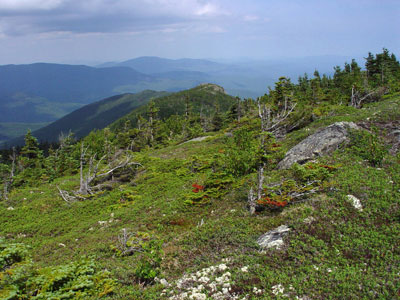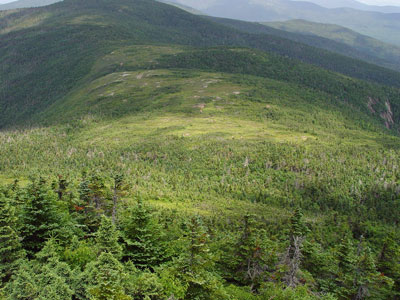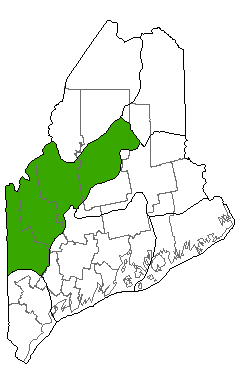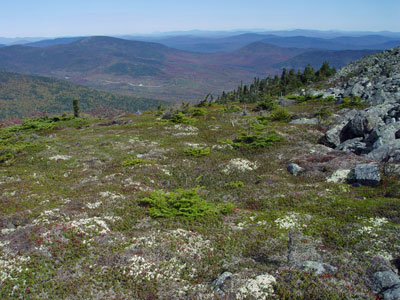DACF Home → Bureaus & Programs → Maine Natural Areas Program → Communities, Plants, and Animals → Natural Community Fact Sheets → Heath Alpine Ridge
Printer Friendly Fact Sheet - 800 KB pdf (Get a free copy of Adobe Acrobat Reader)
Heath Alpine Ridge
Scientific Name: Dwarf Heath - Graminoid Alpine Ridge; State Rank: S2

- Community Description
- Soil and Site Characteristics
- Diagnostics
- Similar Types
- Conservation, Wildlife and Management Considerations
- Distribution
- Characteristic Plants
- Associated Rare Plants
- Associated Rare Animals
- Examples on Conservation Lands You Can Visit
Community Description: This is the one of the most common community types above treeline. Vegetation can be quite variable and is dominated by a mixture of dwarf evergreen shrubs and herbs. Total vegetation cover is usually 35-65%. Shrubs usually make up 40-75% of the vegetation cover. The most abundant herbs are Bigelow’s sedge and highland rush. Several rare species that occur only above treeline are found in this type. In one variant of this type, Bigelow’s sedge is dominant and forms carpets, with heath shrubs and other herbaceous species far more sparse. Back to top.
Soil and Site Characteristics: Sites occupy exposed, windswept ridges above treeline. Moisture conditions range from fairly xeric in exposed areas to moist patches in protected spots. Substrate varies from gravelly flats to stone pavements to rugged fellfields. Back to top.

Diagnostics: Sites are above treeline and dominated by mixed dwarf shrubs, Bigelow’s sedge, and highland rush. Alpine bilberry is prominent. Other strictly alpine species, such as boreal bentgrass, alpine sweet-grass, Lapland rosebay, bearberry willow, or alpine bearberry, are frequent but often at low cover. Back to top.
Similar Types: Windswept Alpine Ridge vegetation has higher cover of diapensia and usually lower cover of graminoids. Rocky Summit Heath and Mid-elevation Bald vegetation lack the strictly alpine species (although alpine bilberry and highland rush may occur in both). Alpine Snowbank vegetation features tundra dwarf birch, moss-plant, or mountain-heath. Alpine Bogs also lack the strictly alpine shrubs and have peat mosses and other wetland plants. Back to top.
Conservation, Wildlife and Management Considerations: Most Maine occurrences of this type occur on public or private conservation land; however, hiker traffic has caused degradation in heavily used areas. As with all above treeline vegetation in Maine, careful trail siting and efforts to minimize off-trail use are the important management considerations.
On the tablelands of Mt. Katahdin, this community type provides the only known habitat in the world for the Katahdin Arctic butterfly. Mt. Katahdin is also the only known nesting area in the state for the American pipit. Back to top.
Distribution: Upper-elevation ridges of Maine's western and central mountains (mostly in the New England - Adirondack Province), extending westward and southward along the Appalachians. Likely extends northeastward to the Gaspé peninsula. Landscape Pattern: Small Patch. Back to top.


Characteristic Plants: These plants are frequently found in this community type. Those with an asterisk are often diagnostic of this community.
- Dwarf Shrub
- Alpine bilberry*
- Diapensia*
- Mountain cranberry
- Herb
- Bigelow's sedge*
- Highland rush*
- Three-toothed cinquefoil
- Alpine blueberry
- Alpine sweet-grass
- Bigelow's sedge
- Boott's rattlesnakeroot
- Boreal bentgrass
- Cutler's goldenrod
- Mountain sandwort
- American pipit
- Katahdin arctic
Examples on Conservation Lands You Can Visit
| Example | County |
|---|---|
| Bigelow Preserve Public Lands | Somerset Co. |
| Goose Eye Mountain, Mahoosuc Public Lands | Oxford Co. |
| Mt. Katahdin, Baxter State Park | Piscataquis Co. |
| The Brothers, Baxter State Park | Piscataquis Co. |
